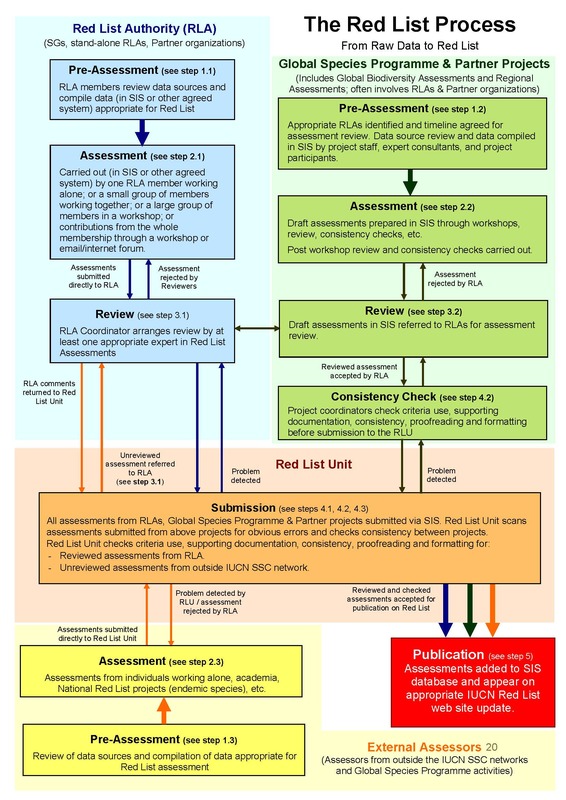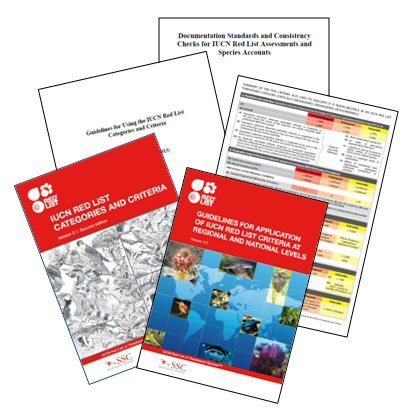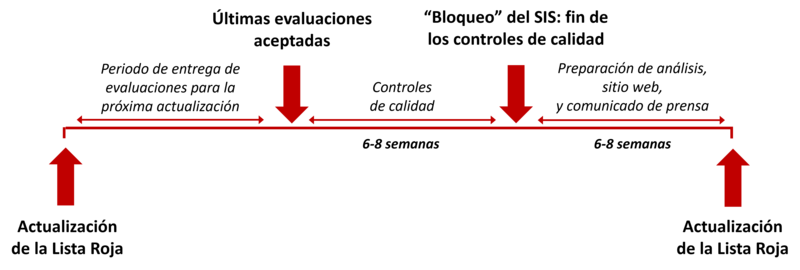De los datos brutos a la Lista Roja
Contenido
- Introducción
- ¿Qué evaluaciones se aceptan para la Lista Roja de la UICN?
- Preparación de evaluaciones para la Lista Roja
- Priorización de esfuerzos para reevaluar los grupos taxonómicos con más especies
- Verificación y revisión de evaluaciones
- Entrega de evaluaciones
- Publicación en la Lista Roja de la UICN
Introducción
La Lista Roja de Especies Amenazadas de la UICN es esencialmente una lista de taxones que han sido sometidos a una evaluación de su riesgo de extinción utilizando las Categorías y Criterios de la Lista Roja de la UICN. La mayoría de las evaluaciones que aparecen en la Lista Roja son realizadas por miembros de la Comisión de Supervivencia de Especies (CSE) de la UICN, Autoridades de la Lista Roja (RLA) designadas, Socios de la Lista Roja o especialistas que trabajan en proyectos de evaluación dirigidos por la UICN. No obstante, cualquier persona con conocimientos suficientes sobre una especie puede realizar una evaluación y someterla a la consideración de la UICN.
La gestión central de la Lista Roja de la UICN corre a cargo de la Unidad de la Lista Roja (RLU), que forma parte de la Secretaría de la UICN. Todas las evaluaciones deben entregarse a la RLU, que comprueba el uso de los criterios, la información de apoyo, la coherencia, etc., antes de publicarlas.

El proceso para completar una evaluación y publicarla en la Lista Roja de la UICN se describe en este diagrama. Más información a continuación.
¿Qué evaluaciones se aceptan para la Lista Roja de la UICN?
La Lista Roja de la UICN acepta evaluaciones de especies a escala mundial.
Las evaluaciones regionales que se han realizado como parte de un proyecto de evaluación regional de la UICN también se incluyen en el sitio web de la Lista Roja. Para más información sobre estas evaluaciones, consulte la página Evaluaciones Regionales de la Lista Roja. Las evaluaciones regionales no dirigidas por la UICN y las evaluaciones de Listas Rojas nacionales no son incluidas en la Lista Roja de la UICN, a menos que se trate también de evaluaciones mundiales (por ejemplo, endemismos de un solo país). Para más información sobre el uso de las Categorías y Criterios de la UICN a nivel regional, consulte las Directrices para el uso de los criterios de la Lista Roja de la UICN a nivel regional y nacional, el sitio web de las Listas Rojas Nacionales y el curso de formación en línea de la Lista Roja.
Las evaluaciones de subespecies, subpoblaciones y (en el caso de las plantas) variedades también pueden aceptarse para la Lista Roja de la UICN, siempre que también se haya realizado la evaluación a nivel de especie. Para más información sobre niveles taxonómicos y el alcance de las evaluaciones de la Lista Roja, consulte las Directrices de uso de las Categorías y Criterios de la Lista Roja de la UICN.
Todas las evaluaciones deben seguir las versiones actuales de las Categorías y Criterios de la Lista Roja de la UICN (disponibles en español, francés, inglés y otros idiomas) y las Directrices de uso de las Categorías y Criterios de la Lista Roja de la UICN.
Preparación de evaluaciones para la Lista Roja
 Todas las evaluaciones publicadas en la Lista Roja de la UICN se introducen, almacenan y gestionan en el Servicio de Información de Especies (SIS) de la UICN. Las evaluaciones también pueden cargarse por lotes desde bases de datos externas a través del SIS Connect.
Todas las evaluaciones publicadas en la Lista Roja de la UICN se introducen, almacenan y gestionan en el Servicio de Información de Especies (SIS) de la UICN. Las evaluaciones también pueden cargarse por lotes desde bases de datos externas a través del SIS Connect.
- Las evaluaciones preparadas por los Grupos Especialistas de la CSE, las RLA, los Socios de la Lista Roja o los proyectos de evaluación dirigidos por la UICN deben finalizarse en el SIS. Los evaluadores que también sean miembros de la CSE deberán ponerse en contacto con el Coordinador de la RLA correspondiente para averiguar cómo se gestiona el proceso de evaluación del grupo (Directorio de Grupos de Especialistas y RLA de la CSE).
- Los evaluadores que no formen parte de la red de la CSE y que no dispongan de una cuenta de usuario en el SIS deberán ponerse en contacto con la Unidad de la Lista Roja de la UICN para acordar un método adecuado para entregar sus evaluaciones.
- La UICN también ha aprobado el uso de RAMAS® Red List, un paquete de software desarrollado por Applied Biomathematics (empresa de software ecológico con sede en Nueva York). Este software aplica las reglas de los Criterios de la Lista Roja de la UICN para obtener una evaluación, e incluye además un algoritmo para tratar explícitamente cualquier incertidumbre en los datos.
Antes de iniciar una evaluación, asegúrese de que el taxón que se va a evaluar sigue las normas taxonómicas utilizadas por la Lista Roja de la UICN.
Es recomendable iniciar una evaluación verificando si el taxón ha sido evaluado previamente (o si hay una evaluación en proceso), así como la fecha y los responsables de la evaluación. Esto se puede comprobar mediante los siguientes medios:
- Si dispone de una cuenta de usuario en SIS, puede buscar el taxón en la plataforma. En SIS, podrá acceder a todas las evaluaciones publicadas, tanto actuales como históricas (si las hay) para cada taxón.
- SIS también le permite ver los borradores de evaluaciones que se están preparando actualmente y qué proyectos y evaluadores están trabajando en ellos. Esto le permite ponerse en contacto directamente con otros evaluadores y evitar la duplicación del trabajo de evaluación.
- También puede buscar el taxón en el sitio web de la Lista Roja de la UICN.
- También puede ponerse en contacto con la Unidad de la Lista Roja.
Todas las evaluaciones deben basarse en los datos actualmente disponibles para el taxón en toda su área de distribución global. Los evaluadores deben tener en cuenta toda la literatura pasada y presente (publicada y gris), así como otras fuentes de información confiables relacionadas con el taxón. Aunque se hace todo lo posible por consultar e incluir todo el material de referencia disponible y relevante, es posible que los evaluadores no hayan tenido acceso a cierta información o no estuvieran al tanto de su existencia. Si dispone de información que considere directamente relevante para una evaluación en particular, especialmente si podría influir en la asignación de una categoría diferente en la Lista Roja, por favor, póngase en contacto con la Unidad de Lista Roja (RLU). La RLU le pondrá en contacto con las personas responsables de la evaluación o les transmitirá cualquier información que proporcione.
 Verifique que dispone de las versiones más recientes de los documentos de orientación pertinentes, ya que algunos se actualizan con regularidad. Puede descargar todos los documentos en la sección de Recursos y Publicaciones.
Verifique que dispone de las versiones más recientes de los documentos de orientación pertinentes, ya que algunos se actualizan con regularidad. Puede descargar todos los documentos en la sección de Recursos y Publicaciones.
Consulte los documentos de orientación a lo largo del proceso de evaluación para asegurarse de que los criterios de la Lista Roja se aplican correctamente. También puede ponerse en contacto con la Unidad de la Lista Roja para obtener asesoramiento sobre la aplicación de los criterios.
Todas las evaluaciones deben incluir también información de apoyo, tal y como se describe en las Directrices para la información de apoyo. En general, esto incluye escribir un resumen de por qué el taxón figura en una categoría determinada; cumplimentar los esquemas de clasificación estándar describiendo los hábitats, las amenazas, etc.; y la presentación de un mapa de distribución.
Priorización de esfuerzos para reevaluar los grupos taxonómicos con más especies
Evaluar para la Lista Roja todas las especies dentro de grupos taxonómicos que contienen muchos miles de especies requiere un esfuerzo y recursos considerables. Mientras que los proyectos que han llevado a cabo evaluaciones iniciales de este tipo de grupos han logrado movilizar fondos sustanciales, es probable que los recursos para las reevaluaciones sean extremadamente limitados. Además, la capacidad humana (coordinadores de proyectos, evaluadores, expertos, revisores, miembros de las RLA, etc.) también es limitada (tanto en el número de personas como en el tiempo que pueden dedicar). Sin embargo, las reevaluaciones son vitales para utilizar la Lista Roja de la UICN como indicador de las tendencias de la biodiversidad a lo largo del tiempo (a través del Índice de la Lista Roja), y todas las evaluaciones de la Lista Roja quedan oficialmente obsoletas al cabo de diez años.
Por tanto, es importante diseñar los proyectos de reevaluación de forma que sean sostenibles, rentables y optimicen al máximo el uso del tiempo y los recursos disponibles. Lógicamente, esto significa dirigir el mayor esfuerzo a la actualización de las evaluaciones de las especies amenazadas y Casi Amenazadas, con especial atención a los taxones cuya categoría pueda estar cambiando, y actualizar la información sobre su distribución, tamaño y tendencia de la población, sus amenazas y acciones de conservación en curso y, en particular, las acciones de conservación necesarias para su protección. También es prioritaria la identificación de especies de Preocupación Menor y de Datos Insuficientes para las que exista nueva información que permita su reevaluación en otra categoría. De menor prioridad es destinar esfuerzos a la actualización de evaluaciones, codificación y descripciones de texto para las especies de Preocupación Menor (en particular aquellas cuya población, distribución y tendencias están claramente lejos de los umbrales de Casi Amenazada) y las especies de Datos Insuficientes para las que no haya información nueva (aunque se requiere cierto esfuerzo para verificar si ha surgido nueva información, publicada o no).
Esto se puede lograr centrando los esfuerzos en:
-
(a) actualizar y mejorar las evaluaciones y la documentación de especies que no sean de Preocupación Menor ni de Datos Insuficientes; o
-
(b) establecer sistemas y procesos para identificar especies de Preocupación Menor que posiblemente requieran ser trasladadas a categorías de mayor riesgo, así como especies de Datos Insuficientes que puedan necesitar reclasificación
Los medios exactos para lograr estos objetivos variarán inevitablemente entre los distintos grupos, pero pueden incluir:
- Evaluar la literatura publicada (científica y divulgativa) y los informes no publicados.
- Consultar a expertos clave (por ejemplo, a través de talleres, correo electrónico, listas de distribución y/o foros públicos de discusión web).
- Analizar conjuntos de datos de monitoreo (de una o varias especies) para determinar tendencias poblacionales.
- Evaluar datos de teledetección para estimar las tasas de pérdida de hábitat dentro de la distribución de cada especie.
- Promover, defender, apoyar y/o financiar trabajo de campo para recopilar nuevos datos relevantes.
Estas acciones ayudan a identificar nueva información para actualizar evaluaciones de especies amenazadas y Casi Amenazadas, así como a detectar datos que sugieran que una especie de Preocupación Menor o Datos Insuficientes podría requerir reclasificación. En la práctica, esto puede significar que las especies de Preocupación Menor o Datos Insuficientes que no sean identificadas como posibles candidatas para reclasificación mediante el punto (b) recibirán una atención limitada durante el proceso de reevaluación.
Verificación y revisión de evaluaciones
Antes de su entrega, todas las evaluaciones deben ser verificadas para garantizar que:
-
Se adjunta toda la información de apoyo requerida y en el formato adecuado.
-
Se han preparado mapas de distribución para todos los taxones evaluados y se han seguido las normas cartográficas.
- Los criterios de la Lista Roja de la UICN se han aplicado de forma adecuada y coherente en todas las evaluaciones.
La verificación de las evaluaciones debe ser realizada por los evaluadores, los coordinadores de las RLA o el personal del proyecto de evaluación.
Todas las evaluaciones presentadas deben ser revisadas por al menos un Revisor designado por una Autoridad de la Lista Roja (RLA) apropiada.
- Las evaluaciones entregadas por grupos de especialistas de la CSE, RLA, socios de la Lista Roja o un proyecto de evaluación dirigido por la UICN deben ser revisadas antes de ser enviadas a la Unidad de la Lista Roja.
- Los evaluadores que no pertenezcan a las redes mencionadas pueden ponerse en contacto directamente con la RLA apropiada para solicitar que revisen sus evaluaciones (véase el directorio de grupos de especialistas y autoridades de la Lista Roja de la CSE para obtener los datos de contacto de todos los coordinadores de RLA). Si no se dispone de una RLA apropiada, las evaluaciones no revisadas pueden enviarse a la Unidad de la Lista Roja (RLU). El personal de la RLU se encargará de que sean revisadas por un experto adecuado.
Normalmente, las revisiones se completan en u n plazo de tres meses desde que se remiten a la RLA. La Unidad de la Lista Roja o el coordinador de la RLA informarán a los evaluadores de cualquier retraso en este proceso. Para más detalles sobre el proceso de revisión y el papel de las RLA en este proceso, véase el Reglamento Interno. Proceso de evaluación de la Lista Roja de la UICN 2017-2020.
n plazo de tres meses desde que se remiten a la RLA. La Unidad de la Lista Roja o el coordinador de la RLA informarán a los evaluadores de cualquier retraso en este proceso. Para más detalles sobre el proceso de revisión y el papel de las RLA en este proceso, véase el Reglamento Interno. Proceso de evaluación de la Lista Roja de la UICN 2017-2020.
Entrega de evaluaciones
Todas las evaluaciones completadas deben entregarse a la Unidad de la Lista Roja de la UICN.
- La entrega de evaluaciones realizadas por los Grupos de Especialistas de la CSE, las RLA, los Socios de la Lista Roja o los proyectos de evaluación dirigidos por la UICN debe hacerse a través del SIS, a menos que se haya acordado lo contrario con la Unidad de la Lista Roja antes de la entrega.
- Las evaluaciones cargadas a través del SIS Connect serán importadas al SIS por la Unidad de la Lista Roja, pero deberán ser comprobadas, finalizadas y añadidas a la lista de entregas del SIS por quienes hayan enviado las evaluaciones.
- Las evaluaciones procedentes de fuera de las redes mencionadas deberán entregarse preferentemente en formato electrónico; el formato adecuado deberá discutirse y acordarse con la Unidad de la Lista Roja antes del envío.
- Si se ha utilizado el RAMAS® Red List para alguna evaluación, los archivos de datos resultantes deben enviarse a la Unidad de la Lista Roja junto con las evaluaciones.
Las evaluaciones entregadas son comprobadas por el personal de la Unidad de la Lista Roja de la UICN (y a veces también por el Subcomité de Normas y Peticiones del Comité Directivo de la CSE-UICN) para garantizar:
- La coherencia en la aplicación de las categorías y criterios de la Lista Roja.
- Que se ha proporcionado la información de apoyo requerida.
- Que se ha proporcionado un mapa de distribución adecuado.
La Unidad de la Lista Roja notificará a los evaluadores, coordinadores de las RLA o gerentes de proyectos de evaluación sobre cualquier problema señalado después de la entrega de evaluaciones.
- Las evaluaciones que sean aceptadas para su publicación aparecerán en una actualización futura de la Lista Roja de la UICN.
- Cualquier evaluación que no cumpla con todos los requisitos para su publicación en la Lista Roja de la UICN (incluidas las evaluaciones rechazadas por los revisores) será devuelta a los evaluadores con una explicación de los problemas identificados. Estas evaluaciones podrán ser revisadas y/o corregidas y entregadas nuevamente en una fecha posterior.
Publicación en la Lista Roja de la UICN
Las evaluaciones pueden ser entregues a la Unidad de la Lista Roja de la UICN en cualquier momento. Sin embargo, la fecha de publicación de una evaluación aceptada dependerá de cuándo se presentó la evaluación y del resultado de las verificaciones finales de calidad por parte de la Unidad de la Lista Roja (véase más arriba «Entrega de evaluaciones»).
Para que la UICN disponga de tiempo suficiente para comprobar las evaluaciones entregadas, analizar los datos, actualizar el sitio web y preparar el material de prensa, se sigue el calendario general que se ilustra a continuación. Tenga en cuenta que el tiempo transcurrido entre la fecha de aceptación de las propuestas finales y la fecha de publicación de la próxima Lista Roja variará en función de los recursos disponibles.

- Todas las evaluaciones finales revisadas y entregadas (a través del SIS o directamente a la Unidad de la Lista Roja) entrarán en una lista de entregas.
- Una vez que las evaluaciones entran en la lista de entregas del SIS, se bloquean para evitar que los evaluadores, las RLA o los gestores de proyectos sigan editándolas mientras la Unidad de la Lista Roja realizan las comprobaciones finales.
- Cualquier evaluación entregada después de la fecha de «últimas evaluaciones aceptadas» permanecerá en la lista de entregas para ser procesada para su publicación en la próxima actualización disponible.
- La fecha de «bloqueo del SIS» se refiere a la fecha en la que todas las evaluaciones aceptadas para su publicación se bloquean en el SIS para impedir que nadie pueda volver a editarlas.
- Todas las evaluaciones no verificadas que permanezcan en la lista de entregas en la fecha de «bloqueo del SIS» se mantendrán en la cola para ser procesadas para su publicación en la siguiente actualización disponible.
Todas las evaluaciones publicadas en el sitio web de la Lista Roja de la UICN están abiertas a cuestionamiento. Se ha desarrollado un proceso de petición para gestionar desacuerdos con las categorías actuales en la Lista Roja.

